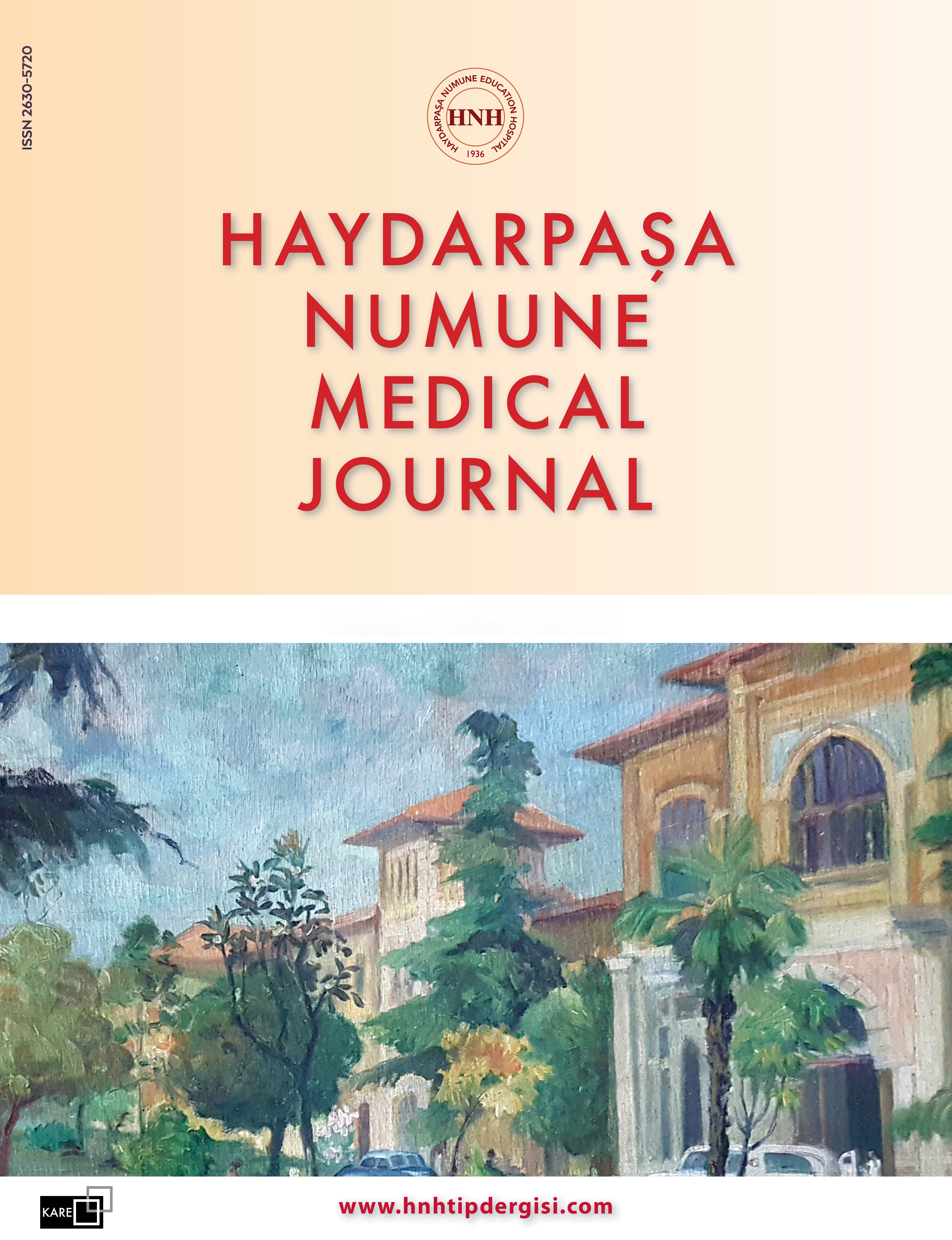Volume: 51 Issue: 3 - 2011
| RESEARCH ARTICLE | |
| 1. | Clinicopathological Evaluation of Our Renal Biopsies In The Last Five Years Alper Bayrak, Toluy Özgümüş, Müjdat Kahraman, Funda Türkmen, Emre Erişkon, Gülistan Gümrükcü, Can Sevinç, Ali Özdemir Pages 94 - 99 INTRODUCTION: Renal biopsy is the gold standard diagnostic choice for renal diseases. It is used for determining the prognosis, and choosing the right treatment modality for renal diseases. The purpose of this study was the clinicopathological evaluation of our renal biopsies in the last 5 years. METHODS: In our study, we evaluated 140 native percutaneus renal biopsies retrospectively, that were taken in the years 2004 2009,from patients interned in the 5th and 2nd Internal Medicine Clinics of our hospital. The biopsies were performed with full-automatic biopsy needles under ultrasonographic guidance. Hematoxylin-Eosin (HE), Periodic Acid-Schiff(PAS), Periodic Acid-Schiff Metanamine (PAS-M), Masson Trichrome, Crystal Violet and Kongo Red were applied for light microscopy; and IgG, IgM, IgA, C3, and Fibrinogen antibodies were applied with the direct immunfluorescent method for Immunofluorescent study. RESULTS: The mean age was 43.2±17.1. 81 of 140 patients were male(58.7%), whereas 57 patients were female(41.3%). There were a minimum of 2 and maximum 37 glomerules (Mean glomerule Count: 15.3±7.5) in the biopsy samples. Sufficent glomerule number was met in 70% cases (98/140). Most common endication for biopsy was nephrotic syndrome in 85 of 140 (60.7%) patients; whereas most common diagnosis was Focal Segmental Glomerulosclerosis (FSGS) (N=29, 21%). DISCUSSION AND CONCLUSION: In our study most common diagnosis was FSGS; and second most common was amiloidosis. Even though in many studies the most frequent renal-biopsy diagnosis is Bergers nephropathy; in our study it was as low as 5.8%. Furthermore; upon futher examination of the biopsies diagnoased as FSGS; we have come to the conclusion that a considerable portion of them might in fact be benign nephrosclerosis, and when diagnosing biopsy samples as FSGS, considering secondary FSGS with a thorough clinicopathological evaluation would be beneficial for both treatment and prognosis. |
| 2. | The General Level of Satisfaction With Outsourced Services In a Training and Research Hospital Aslı Ekin, Aygül Yanık, Mithat Kıyak Pages 100 - 108 INTRODUCTION: This study aimed to determine the reasons for preferring and not preferring outsourced services and the general level of satisfaction with these services among the personnel of a training and research hospital in Istanbul. The non medical outsourced services involved special security, catering (nutrition), information technologies, general cleaning services with supplies, and technical maintenance whereas the outsources medical services involved computerised tomography services. METHODS: We conducted face-to-face interviews and used questionnaires developed by the researchers. A 5 Likert type scale was used in the questionnaire. RESULTS: The SPSS 11.5 was used to evaluate the weight of the answers in the questionnaire. The sample of the research consisted of 300 regular personnel who have been chosen with random sampling. DISCUSSION AND CONCLUSION: The subcontractor personnel and assisting attendants were excluded from the study. This was a descriptive study. According to the results, it has been determined that the personnel had a positive perspective regarding the utilization of outsources services (UOS). Main reasons for preferring UOS were maintaining the continuity of services (67.9%), whereas reasons for not preferring these services were that the personnel would worry about losing their jobs (53.6%). It has been found that the personnel was not satisfied with UOS (general cleaning 51.5%, catering 62.2%). Although findings regarding UOS seem to be consistent with the literature, institutions may have different priorities regarding reasons for not benefiting from UOS and the level of satisfaction with outsourced services may vary. On the other hand, it has been shown that UOS may have positive contributions. |
| 3. | Results Of The Horizontal Strabismus Surgery In Intermittent Exotropia Deniz Yıldız, Baran Gencer, Nazan Erda Pages 109 - 119 INTRODUCTION: We aimed to evaluate the surgical outcomes and recurrent rates of our patients with intermittent exotropia (X(T)) underwent horizontal strabismus surgery in this study. METHODS: Retrospectively we recruited 70 patients with X(T) during 17 years in this study. All cases were seperated into four groups according to one hour diagnostic occlusion test (DOT): 1. Basic type 2. Divergence excess 3. Convergence insufficiency 4. Pseudodivergence excess. Bilateral resection of medial rectus muscle (MR), unilateral resection of MR, combined recession-resection, bilateral recession lateral rectus muscle (LR) and unilateral recession of LR were applied by two surgeons according to types of X(T). The postoperative following mean period was 31.4±25.6 months (6 months-9 years). Postoperative ±10 prism dioptric (PD) deviation was accepted for surgery success. RESULTS: After DOT, we found 38 patients were basic type, 19 patients were divergence excess, 13 patients were convergence insufficiency. Forty patients underwent bilateral resection of MR, 5 patients underwent unilateral resection of MR, 5 patients underwent combined recession-resection, 12 patients underwent bilateral recession of LR and 8 patients underwent unilateral recession of LR. In all cases, the mean distance deviation was -27.5±12.9 PD preoperatively. It was found between -3.5±4.4 PD and -8.5±6.6 PD postoperatively. The mean near deviation was -24.3±13.6 PD preoperatively. It was found between -3.1±4.7 PD and -8.2±7.7 postoperatively. In all cases postoperatively success rate was 84.2% at distance, 81.4% at nearby. We observed 20 (28.6%) recurrent cases during follow up. DISCUSSION AND CONCLUSION: We suggested to apply DOT to X(T) patients for detecting the maximal deviation angle and subgroups of X(T) for surgery success. |
| 4. | How To Obtain Ideal Pain Control During Transrectal Ultrasound (Trus) Guided Prostate Biopsy?: Comparative Results Of Topical And Infiltrative Anesthetics Combined With Analgesics Fikret Fatih Önol, Cem İpek, Uğur Boylu, Eyüp Veli Küçük, Fettah Tosun, Eyüp Gümüş Pages 120 - 125 INTRODUCTION: To compare the efficacy of various anesthetic and analgesic combinations in pain control during prostate biopsy, and to develop a minimally invasive protocol aimed to improve patient comfort and raise the quality of sampling during biopsy. METHODS: Between February 2008 and June 2009, patients with a high PSA (>2.5 ng/ml) and/or abnormal digital rectal examination findings who underwent standard 10-core TRUSguided prostate biopsy were included. Patients were randomly divided into: Intrarectal topical lidocaine 2% gel + Pethidine HCl 100mg im (Group 1, n: 25), topical lidocaine 2% + Lornoxicam 8mg im (Group 2, n: 21), topical lidocaine 2% + midazolam 3mg i.m (Group 3, n: 20), apical infiltration with 2% prilocaine + Pethidine Hal 100mg im (Group 4, n: 28), 2% prilocaine + Lornoxicam 8mg im (Group 5, n: 54), 2% prilocaine + Midazolam 3mg i.m. (Group 6, n: 45) into six groups. Severity of pain was assessed with visual analogue scale (VAS) ranging from 0 (no pain) to 10 (worst pain during lifetime). RESULTS: Mean age was 64.7±8.7 years. There was no difference between groups for age, serum PSA levels and prostate volume (p> 0.05). Local anesthesia + larnoxicam (group 5) provided the best, topical anesthesia + midazolam (group 3) provided the worst pain control. Combination of analgesics with local anesthesia (groups 4,5,6) resulted in lower VAS scores as compared to combination with topical aesthetic (groups 1,2,3). The addition of Pethidine to topical lidocaine showed an equivalent efficacy with local anesthetic groups. DISCUSSION AND CONCLUSION: Topical lidocaine + Pethidine combination is an alternative to local infiltrative anesthesia for pain control during prostate biopsy. |
| 5. | Antenatal Hepatitis B Seroprevalence In Agrı City Mustafa Kara, Ercan Yılmaz, Emel Kıyak Çağlayan Pages 126 - 130 INTRODUCTION: Hepatitis B infection is a worldwide health problem because of causing acute, fulminant and chronic hepatitis, which may result in cirrhosis and finally hepatocellular cancer. Hepatitis B Virus infection in the pregnants is also an important health problem because of the vertical transmission. We aimed to search the HBsAg positivity and its relationship with the socio-demographic factors in the pregnants referred to our clinic in the antenatal period. METHODS: One hundred forty pregnant women aged 15-44 were included our study in 2009 January-July. Pregnants were classified with their socio-demographic parameters (birth place, health insurance, profession, previous surgery etc). RESULTS: HBsAg positivity was detected only in 9 patients (%6,4), and antiHBs antibody positivity was detected in 20 patients (%14,2). Statistically significant HBsAg positivity was found higher in patients with previous sectio history than in patients without previous sectio history (respectively, 15.3 % vs. 5.5 %, p< 0.05). Pregnants with surgical procedure history (C/S cases not included), also had a significantly high HBsAg positivity against non-operated pregnants (respectively, 12.9 % vs. 4.5 %, p< 0.05). AntiHBs antibody positivity was found 62.5 % in pregnants work at health career and 11.3% in pregnants work in other fields. DISCUSSION AND CONCLUSION: HBsAg positivity was found to be consistent with other previous study results. High levels of HBsAg positivity should be kept in mind in the patients who previously underwent surgery or sectio. But, the other routes of contamination should be evaluated. |
| 6. | Aortic Stifness In Patients With Rheumatoid Arthritis Seval Masatlıoğlu, Semiha Ayaydın, Refik Demirtunç, Güven Yılmaz, Nilcihan Yolcu, Kadir Kayataş, Dursun Duman Pages 131 - 137 INTRODUCTION: In patients with RA, the cardiovascular system involvement is the most important reason for the increase of mortality. Evaluation by non-invasive methods of mechanical properties of the aorta is quite useful in early diagnosis of atherosclerosis. In this study we have investigated that the relation between aortic elasticity parameters and the disease activity criteria in the RA patients who has not have any risk factors and any diseases leading to the development of atherosclerosis. METHODS: 46 RA patients and 20 healthy subjects were included in the study. The patients, disease duration and DAS-28 scores and ESR and CRP and lipid parametres results were recorded. Echocardiographic evaluation was performed and the aortic elastic parameters were calculated and compared between groups. Activity parameters of patients with RA and the relation between aortic elastic parameters were investigated. RESULTS: Aortic strain and distensibility levels of RA patients, were lower than the control group (p <0.002). According to there is no statistically significant difference between patient and control groups. There is a statistically significant relationship between DAS28 and distensibility (p <0.05). And there is a statistically significant correlation between ESH and distensibility (p <0.01). And there is advanced level of statistically significant correlation between strain and the ESH (p <0.01). DISCUSSION AND CONCLUSION: Aortic elasticity parameters measured by echocardiography as a noninvasive method may be useful to predict the risk of cardiovascular disease at early stages. |
| CASE REPORT | |
| 7. | Ileum Perforation After Radiotherapy ( Case Report ) Bülent Kaya, Umut Kerimoğlu, Cengiz Eriş, Hüseyin Bilge, M. Kamil Yıldız, Rıza Kutanış Pages 131 - 141 Pelvic radiotherapy is commonly used in treatment of many malignities. The early and late term effects of radiotherapy on gastrointestinal system are well known. Enteritis in early period is usually treated with conservative measures. Complications such as intestinal adhesion, obstruction, perforation and fistula formation are needed surgical intervention. Intestinal perforation due to radiotherapy is rare. The signs of acute peritonitis are delayed and cause diagnostic difficulties. We are presenting a patient with late signs of acute abdomen after his admission. He was operated due to intestinal perforation after radiotherapy. |
| 8. | The Sequel of Osteoporosis is Skipping? Cumali Karatoprak, Kadir Kayataş, Refik Demirtunç, Hanifi Kılızaslan, Servet Yolbaş, Müjgan Balta, Seyit Uyar Pages 142 - 145 Osteoporosis; the weakening of the bone due to a decrease in bone mass, is a skeletal disease that increase the risk of fractures especially in the spine, hip and wrist. Diagnosis of osteoporosis often is reduced in postmenopausal or senile osteoporosis, in patients with low bone mineral density (BMD) therapy is started with the diagnosis of primary osteoporosis. This situation leads to delay the diagnosis of secondary osteoporosis or causes to be bypassed. We wanted to present a patient who applied to a private hospital with low back pain 6 mount ago and according to the dual energy Xray Absorptiometry (DEXA) measurement diagnosed as osteoporoses and bisphosphonate treatment was started and then diagnosed as multiple myeloma in our internal medicine department. |
| 9. | Sturge Weber Syndrome Presented With Post Traumatic Convulsion Zehra Esra Önal, Tamay Özkozacı, Abdülkadir Tekin, Çağatay Nuhoğlu Pages 146 - 148 Sturge weber syndrome is a sporadic neurocutaneous disease, characterized by facial port-wine stain, ocular abnormalities (glaucoma and choroidal hemangiomal) and leptomeningeal angioma. Clinical features vary from mild incomplete forms to complete disease with facial stain, seizures, mental retardation and glaucoma. Children born with a port wine stain on the upper part of the face are at risk for brain involvement. These infants and young children often develop seizures and other neurologic impairments. Eight months aged girl was taken to our clinic, presenting with the symptoms of vomiting, convulsions after having been dropped (trauma). She had a port-wine stain in her upper part of the face. Contrast enhanced MRI of brain revealed leptomeningeal angiomatosis and cerebral atrophy. Although neurologic development is normal in the first year of life, infants and young children with Sturge Weber syndrome, should be diagnosed as early as possible because focal convulsions and local hypoxia can cause cerebral atrophy, that is responsible for mental retardation, attention disorders and learning disabilities. |
















